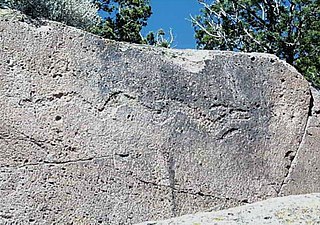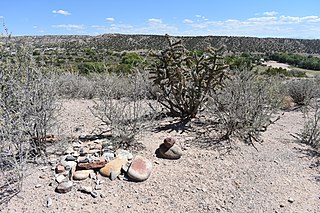
Aragon is an unincorporated community and census-designated place on the Tularosa River in Catron County, New Mexico, United States. As of the 2010 census it had a population of 94. It is located at an altitude of 7,135 feet (2,175 m), 7 miles (11 km) northeast of Apache Creek.

The Rio Chama, a major tributary river of the Rio Grande, is located in the U.S. states of Colorado and New Mexico. The river is about 130 miles (210 km) long altogether. From its source to El Vado Dam its length is about 50 miles (80 km), from El Vado Dam to Abiquiu Dam is about 51 miles (82 km), and from Abiquiu Dam to its confluence with the Rio Grande is about 34 miles (55 km).

Tsirege is a classic Anasazi Pueblo archaeological site located north of Pajarito Road about one mile west of White Rock, New Mexico on property owned by Los Alamos National Laboratory. Tsirege consists of approximately 800 rooms, was occupied from c. 1325 to c. 1600, and is regarded by the people of San Ildefonso Pueblo as ancestral. The name means "bird place" in the Tewa language. The site includes a long defensive wall, 10 kivas, a reservoir, and many significant petroglyph panels. Tours of the site are rarely offered.

Capulin is a census-designated place and U.S. Post Office in Conejos County, Colorado, United States. The ZIP Code of the Capulin Post Office is 81124. The population as of the 2010 Census was 200.

Eastside Cannery Casino and Hotel is a locals casino on the Boulder Strip in Sunrise Manor, Nevada, owned and operated by Boyd Gaming. The Eastside Cannery has 65,000 sq ft of casino space, 307 hotel rooms, a special events ballroom, a private club on the 16th floor, one restaurant and two bars.

Ojo Caliente Spring is a hot spring in Lower Geyser Basin, of Yellowstone National Park. It is in the River Group which includes Azure Spring, and is located a few yards off the Fountain Flats Freight Road on the northern bank of the Firehole River.

Victorio's War, or the Victorio Campaign, was an armed conflict between the Apache followers of Chief Victorio, the United States, and Mexico beginning in September 1879. Faced with arrest and forcible relocation from his homeland in New Mexico to San Carlos Indian Reservation in southeastern Arizona, Victorio led a guerrilla war across southern New Mexico, west Texas and northern Mexico. Victorio fought many battles and skirmishes with the United States Army and raided several settlements until the Mexican Army killed him and most of his warriors in October 1880 in the Battle of Tres Castillos. After Victorio's death, his lieutenant Nana led a raid in 1881.
Sapawe or Sepawe is a Tewa Pueblo ancestral site in an address-restricted area near El Rito, New Mexico. It was occupied from around 1350 until around 1550.
Howiri is a Tewa Pueblo ancestral site in Taos County, New Mexico, United States. Its ten circular kivas are located on the east bank of Rio Ojo Caliente, near Homayo. It was occupied from around 1400 until around 1525. In 1983, it was listed on the National Register of Historic Places listings in Taos County, New Mexico.
El Rito,, is an unincorporated community in Rio Arriba County, New Mexico, USA. Its elevation is 6,875 feet (2,096 m).
Homayo is one of the principal Tewa Pueblo ancestral sites in New Mexico, US. Located on the west bank of the Rio Ojo Caliente, there are seven kivas. It is a large, compactly built pueblo ruin situated on a promontory on the west side of the river about a 1.5 miles (2.4 km) above Posege. The walls are of adobe about 1 foot (0.30 m). The kivas vary from 30–50 feet (9.1–15.2 m) in diameter and are all of the circular form. The village was well situated for defense, as it can be approached readily from the west side only. There is one main plaza or court which appears completely closed. Attached to this on the east are two sections which partially enclose another and smaller court. Three detached sections stand at a little distance from the main quadrangle.
Teeuinge is one of the principal Tewa Pueblo ancestral sites in New Mexico, US. It is situated in the southerly angle formed by the juncture of Rio Oso and Rio Chama. The site measures approximately 525 feet (160 m) by 210 feet (64 m). It is a large ruin situated on the rim of the mesa overlooking the valley, just below the confluence of the two rivers. It is about .25 miles (0.40 km) south of the river, and the bluff on which it stands is about 200 feet (61 m). The pueblo was constructed of adobe with some use of lava blocks in the foundation walls, and is now reduced to low mounds. It was built in two large adjoining quadrangles, or as one long rectangle divided by cross walls into two courts. The walls have a perimeter of 1,470 feet (450 m). Within and contiguous to the pueblo are ten circular, subterranean kivas. A few yards to the east is a ruined shrine in circular form, 8 feet (2.4 m) in diameter, built of lava blocks set on edge.
Canada Alamosa an Americanized version of the Spanish Cañada Alamosa, is a term historically applied to five geographical features, all in the same immediate area in southwest Socorro and northwest Sierra Counties, New Mexico. In historical texts the name, Canada Alamosa is applied inter-changeably to the five features, and it is often only the context that distinguishes one feature from the other.

Los Ojos is a census-designated place in Rio Arriba County, New Mexico, United States. Its population was 125 as of the 2010 census. Los Ojos has a post office with ZIP code 87551, which opened on February 7, 1877. The community is near U.S. Route 64 and U.S. Route 84.
Stinking Lake is a lake in Rio Arriba County, New Mexico, in the United States.
Capulin Peak is a summit in Rio Arriba County, New Mexico. It reaches an elevation of 9199 feet / 2804 meters. Its former name in the Tewa language of the nearby Puebloan peoples was Abepin. Its Spanish name was Cerro Capulin, Capulin meaning Choke Cherry. The Armijo Route of the Old Spanish Trail ran westward at the foot of the peak at its south. This route is now closely followed or paralleled by New Mexico, New Mexico State Road 96.

Posi-ouinge is an archeological site in Rio Arriba County, New Mexico and Taos County, New Mexico near Ojo Caliente. It was listed on the National Register of Historic Places in 1993 for its information potential.
Ojo Caliente, is a spring in the Monticello Canyon in Socorro County, New Mexico. It is located at an elevation of 6,263 feet / 1,909 meters in Spring Canyon, a tributary of Alamosa Creek.











